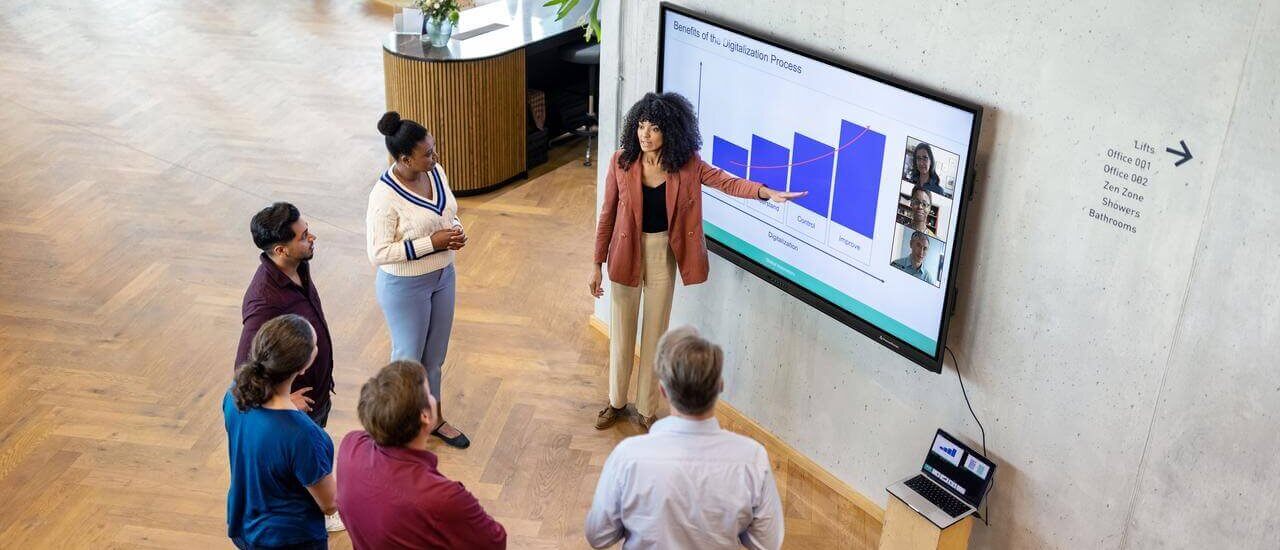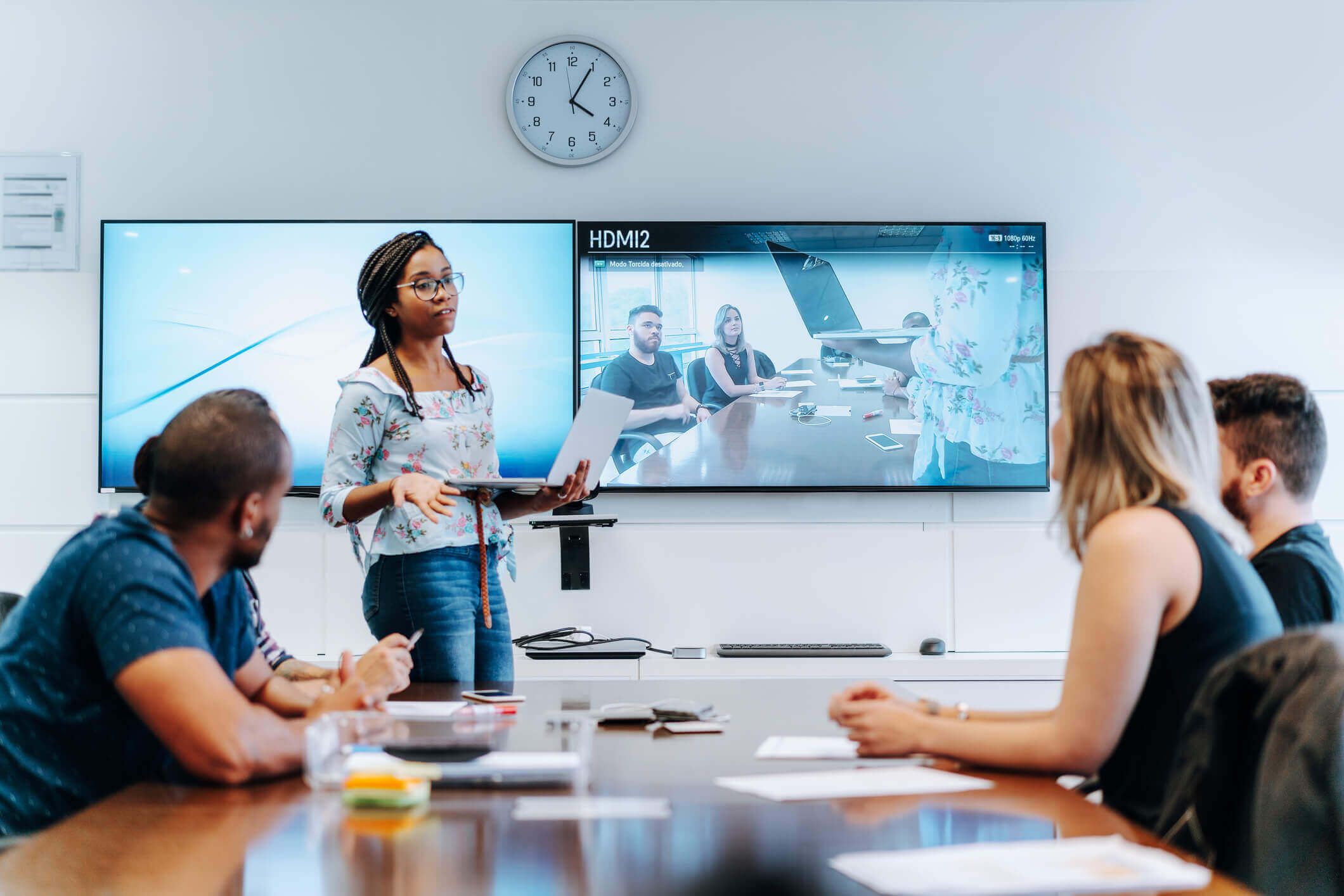Published on December 2nd, 2024
Collaborative Workspaces: How to Design Office Spaces that Foster Collaboration Among Employees
15 minute read

Summary
Collaborative workspaces are office spaces that are designed to help employees work together, stimulating productivity, creativity, communication, and problem solving. The term is also used to refer to office spaces intended for shared use by multiple businesses at once or, more commonly, by freelancers. In this article, we’ll be focusing on collaborative workspaces specifically for your business, though it’s worth noting that many of the principles will be equally relevant to shared spaces.
Over the past 40 years we’ve seen the office workplace undergo a series of transitions as we search for the optimal office design to facilitate collaboration and productivity. The sterile cubicles of 1980s corporate America are almost unrecognisable from the open-plan offices of the 00s. Each style was designed in response to the needs of the workforce at the time, with employees in the 80s craving a distraction-free environment before the pendulum swung and greater proportions of the workforce advocated for more collaborative spaces.
The landscape finally appears to be calibrated with a general understanding that productive collaboration doesn’t necessarily equate to sustained group work. Instead, there seems to be an acknowledgement that collaborative styles depend on personal preference and the nature of the task at hand, and that our team workspaces need to be flexible in their design to accommodate those differences.
What is a Collaborative Office Space?
Traditionally, a collaborative office space may have looked like an open plan office or perhaps a flexible, informal space with comfortable seating. In the modern workplace, the form varies according to the function,so it’s useful for us to understand the different types of collaboration before we consider how our spaces might support these.
The Harvard Business Review identifies three types of collaboration:
- Controlled attention
- Stimulus-driven attention
- Rejuvenation
Controlled attention refers to the state required for tasks that need intense focus, such as problem solving, data analysis, or report writing. While working on tasks such as these, we actively want to avoid distractions or disruptive external stimuli.
Stimulus-driven attention describes the state in which we’re able to switch focus when something requires our attention. This mode is typically suited to administrative tasks, such as responding to emails, logging timesheets, or filing invoices. During these periods, we may actively welcome distractions.
Rejuvenation describes the periodic respites we take from concentration throughout the working day, and it’s a chance for our brains and bodies to recharge. How we do this will depend on our personality types – more introverted individuals may seek quiet and solitude, while those who are extroverted will seek social stimuli.
The ideal working environments required to support each of these modes of collaboration – which we should acknowledge are likely simplifications of a much more complex paradigm – will naturally vary substantially.
What’s evident is that we can no longer rely on a one-size-fits-all approach, nor can we expect our employees to work in one fixed environment indefinitely. We need to give them the ability to move between spaces that support the mode of focus they require for any given period.
Designing Collaborative Workspaces
Along with the acknowledgment that different collaboration spaces can support different styles of work and focus has come the introduction of office zoning.
Office Zoning
Office design specialists Amicus identify three common workplace zones:
- Quiet Zones: Independent or private spaces free of distractions where employees can focus on a task or even relax if they’re craving solitude.
- Open work zones: An open area with comfortable and ergonomic seating that encourages connection and informal conversation.
- Collaboration zones: Creative spaces equipped with resources for both in-person and hybrid collaboration (such as interactive displays) that encourage employees to make noise and exchange ideas.
With these three primary zones, it’s quite clear how the environments of each map onto the three types of collaboration identified by the Harvard Business Review. Quiet zones – perhaps with pods or cubicles – are ideal for tasks that require controlled attention, or for more introverted workers who need to rejuvenate. Open work zones support stimulus-driven attention, and collaboration zones provide spaces for both stimulus-driven attention and rejuvenation for more extroverted colleagues.
In each of our office zones, it’s important that we set clear expectations around their intended use in order to facilitate the type of behaviour we expect them to elicit. For this, we will need to rely on the example of leaders, and the design and furniture choices we make for each zone.
Designing and Furnishing Your Spaces
When designing each of your collaborative office spaces – whether they are quiet focus zones or open collaborative areas – the Harvard Business Review recommends considering seven key attributes. Understanding how you want your space to be used and mapping them to these attributes will help guide the design of your space:
- Location – the degree to which the space is open to all or a few
- Enclosure – the degree to which the space is enclosed by walls, doors, or ceilings
- Exposure – the degree to which the space offers visual or acoustic privacy
- Technology – the degree to which the space incorporates high-tech tools
- Temporality – the degree to which the space invites occupants to linger
- Perspective – the direction in which the space focuses the user’s attention
- Size – the usable square footage of the space
To consider each of these in context, let’s imagine we’re looking to design a space for our employees to take private phone calls – perhaps with a client or supplier. We’ll be looking to create a space that can only be used by one or maybe two people at a time (location) and is fully enclosed (enclosure). Acoustic privacy is important though visual privacy may not be (exposure), and our tech needs are basic to non-existent (technology). We don’t want to encourage our employees to use these spaces outside of phone calls (temporality), and we want a space that will be free of distractions allowing employees to focus on their call (perspective); a small space will be adequate (size).
Taking the above into consideration, the ideal space for this function is likely to be a fully enclosed booth, perhaps with one glass panel to prevent intrusions. It can be small and relatively bare with little technology, and a stool facing the wall to prevent distractions.
While the seven attributes provide a good starting point for helping us understand how the design of our collaboration space can support its function, it’s worth considering how our decor and furniture may also impact its use. Lots of loud colours and artwork might be ideal for inspiring creativity but could prove distracting or overstimulating for tasks that require quiet focus. Ergonomic desks and upright chairs are perfect for cultivating that focus but are too rigid and obstructive for group collaboration and open discussion – which could also be disruptive for other users.
Inspiring Collaboration Among Employees
In their article, Eight Ways to Build Collaborative Teams, Gratton and Erickson note that simply designing collaborative workspaces is not enough to inspire productive collaboration within our teams. Our teams need to see our collaborative values reflected in the actions of our senior leaders.
In the context of the optimal use of team workspaces, this might look like leaders demonstrating the adaptability and flexibility they expect to see in their workforce. This means having leaders who aren’t unapproachable and locked away in private offices but can move through various office spaces depending upon the requirements of a given task and recognise the importance of rejuvenation for powering productivity and improving team collaboration.

Online Shared Workspace
In an increasingly globally connected world where we aren’t always physically present in the workplace, it’s essential to replicate our shared workspaces in the digital world.
The role of open work zones in offices is to facilitate discussion and collaboration, leading to ad hoc conversations that inspire creativity and problem solving, supporting stimulus-driven attention. We can replicate that space in the digital world by using video conferencing software such as Microsoft Teams, Slack, or WhatsApp, allowing our employees to troubleshoot and cooperate with each other in real time.
Video conferencing is a powerful complement to instant messaging or email, allowing for enhanced collaboration among employees and reducing the likelihood of misunderstandings through the conveyance of tone of voice and body language, which are absent from written communications. It also allows us to bring remote or hybrid workers into our office collaboration zones – especially if we’re using interactive displays. They can engage in group conversations, and with online collaborative tools such as Miro, Figma, or Microsoft Whiteboard they can also participate in what are traditionally kinetic tasks – mind mapping and card sorting activities, for example.
Group channels can be used to bring colleagues together around a particular theme or project for information sharing, much like one might do in an open office. These tools provide the flexibility for each individual to set parameters around their availability. So, much like in the physical office where we might take ourselves away to a booth or cubicle if we need to focus on a task, we can simply log out or set our status to ‘do not disturb’ to create some digital solitude. This is analogous to using a quiet zone for controlled attention or rejuvenation, though it does of course depend on the individual also having access to a physical space that supports this – perhaps a home office or local library.
Tools such as Google Drive or Microsoft Teams offer these video conferencing tools, but go one step further, providing entire online shared workspaces alongside their communication platforms. These are spaces where we can store and work on documents, either in isolation or collaboratively, assigning tasks to colleagues or editing documents concurrently in real time. They combine project management tools, shared calendars, and even social spaces, providing a digital space for the rejuvenation phase of collaboration that we explored at the beginning of this article. They even allow managers to publicly praise or celebrate the achievements of their team members using things like badges – an important part of collaboration that’s natural in the physical office but so easily lost in the digital world.
Optimising Your Collaboration Spaces
When designing collaboration spaces for your employees, employ the following steps to ensure that they can cooperate comfortably and productively on a range of tasks:
- Recognise the different types of collaboration and how these might differ across personality types.
- Consider how your physical spaces support these types of collaboration and mark out clear zones for each.
- Furnish and decorate your spaces in a manner that supports the individual function of each.
- Ensure these spaces are replicated in your digital workspace and invest in tools that allow you to combine the physical and digital spaces seamlessly.
Promethean’s interactive displays and accessories empower you to bring your digital workspaces into your physical ones, allowing your employees to collaborate creatively and effectively no matter where they’re located. Contact us today to request a free demo.
Further reading:

